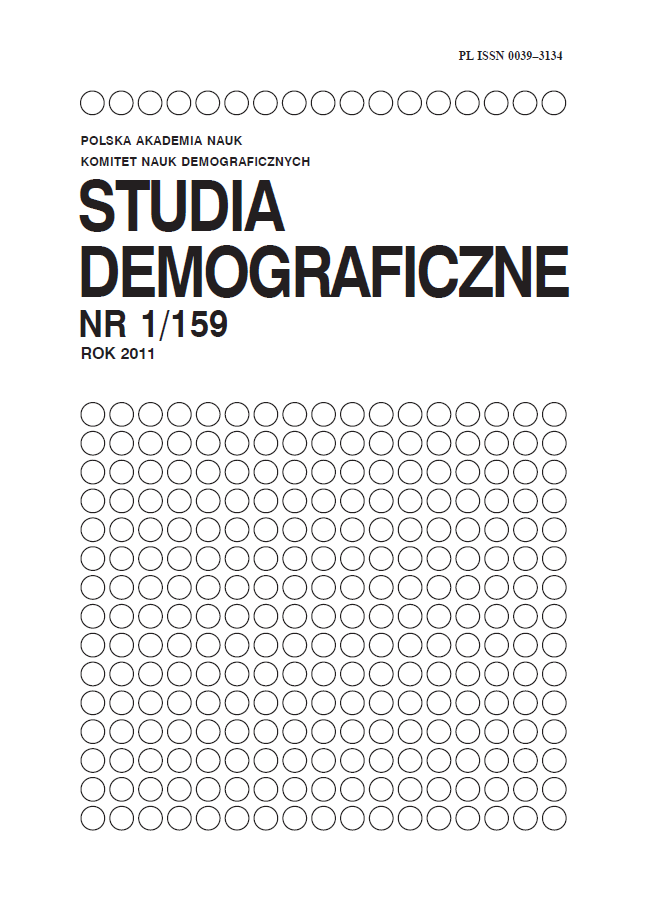Posiadanie własnego mieszkania a rodzicielstwo w Polsce
Main Article Content
Abstract
Having a home of one’s own was enumerated by Hobcraft and Kiernan (1995) as one of the five pre-conditions for the entry to parenthood in industrialised economies. The importance of home ownership for the decision to become a parent has not been investigated for Poland, however. This article aims at filling partly this gap through examining the relationship between home ownership and first birth among Polish women born 1971–1981. This research issue is considered to be important due to a decline in the number of dwellings completed each year as well as the enormous increase in housing prices that were observed in Poland after 1989.
Our empirical findings point out a strong and positive relationship between home ownership and entry to motherhood. More in-depth analyses show that this result is mostly to be attributed to the fact that parents-to-be condition the realisation of their childbearing plan made in the past on becoming a home owner. It is to be noted, that rental accommodation is a far less attractive option for persons planning a child, as is the residence at parents’ dwelling. These results are largely consistent with empirical findings of other researchers investigating this issue in other industrialised economies and suggest that difficulties with a home purchase are one of the reasons for fertility postponement in Poland.
Article Details
References
[2] Baranowska A., 2009, Decyzje kobiet u progu wejścia w dorosłość: inwestycja w karierę zawodową czy rodzinną? Rola kapitału ludzkiego i uwarunkowań instytucjonalnych, [w:] Kotowska I.E., Sztanderska U., Wóycicka I. (red.), Kulturowe i strukturalne uwarunkowania aktywności zawodowej kobiet w Polsce, Wydawnictwo Naukowe Scholar, Warszawa, 175–196.
[3] Baranowska A., 2011, Trash contracts? The impact of temporary employment on leaving the parental home in Poland, „Studia Demograficzne”, nr 1/2011 (w druku).
[4] Eurostat, 2006, Housing Statistics in European Union 2005/2006, I.H.F. Ferdercasa, Rzym.
[5] Feijten P., Mulder, C., 2002, The Timing of Household Events and Housing Events in the Netherlands: A Longitudinal Perspective, „Housing Studies”, vol. 17, no. 5, 773–792.
[6] Frejka T., 2008, Overview Chapter 5: Determinants of family formation and childbearing during the societal transition in Central and Eastern Europe, „Demographic Research”, vol. 19, artykuł 7, 139–170.
[7] Global Property Guide, http://www.globalpropertyguide.com/Europe/Poland/price-gdp-per-cap [dane z dnia 20.12.2011]
[8] GUS, 2003a, Rocznik Statystyczny Polski 2002, Główny Urząd Statystyczny, Warszawa.
[9] GUS, 2003b, Warunki mieszkaniowe gospodarstw domowych i rodzin 2002, Główny Urząd Statystyczny, Warszawa.
[10] GUS, 2004, Rocznik Statystyczny Polski 2003, Główny Urząd Statystyczny, Warszawa.
[11] GUS, 2006, Mały Rocznik Statystyczny Polski 2005, Główny Urząd Statystyczny, Warszawa.
[12] GUS, 2007, Mały Rocznik Statystyczny Polski 2006, Główny Urząd Statystyczny, Warszawa.
[13] Hiscock R., Kearns A., MacIntyre S., Ellaway, A., 2001, Ontological Security and Psycho-Social Benefits from the Home: Qualitative Evidence on Issues of Tenure, „Housing, Theory and Society”, vol. 18, no. 1–2, 50–66.
[14] Hobcraft J., Kiernan, K., 1995, Becoming a parent in Europe, prezentacja na Europejskiej Konferencji Ludnościowej, Mediolan, Włochy.
[15] Kotowska I.E., 1999, Drugie przejście demograficznego i jego uwarunkowania, [w:] Kotowska I.E. (red.), Przemiany demograficzne w Polsce w kontekście drugiego przejścia demograficznego, Szkoła Główna Handlowa, Warszawa, 11–33.
[16] Kotowska I.E., Jóźwiak J., Matysiak A., Baranowska A., 2008, Poland: Fertility decline – a response to profound societal change and transformations in the labour market? „Demographic Research”, vol. 19, artykuł 22, 795–854.
[17] Krishnan V., 1988, Homeownership: its impact on fertility, Research Discussion Paper 51, The University of Alberta, Department of Sociology, Edmonton.
[18] Krishnan V., 1995, Effect of housing tenure on fertility, „Sociological Spectrum”, vol. 15, no 2, 117–129.
[19] Kulu H., Vikat A., 2007, Fertility differences by housing type: The effect of housing conditions or of selective moves?, „Demographic Research”, vol. 17, no. 26, 775–802.
[20] Matysiak A., 2009, Employment first, then childbearing: Women’s strategy in post-socialist Poland, „Population Studies-a Journal of Demography”, vol. 63, no. 3, 253–276.
[21] Megbolugbe I.F., Linneman P.D., 1993, Home ownership, „Urban Studies”, vol. 30, no. 4/5, 659–682.
[22] Michielin F., Mulder C.H., 2005, Fertility choices of couples and relocations in the life course, prezentacja na IUSSP XXV International Population Conference, Tours, Francja.
[23] Mulder C.H., 2006, Home-ownership and family formation, „Journal of Housing and the Built Environment”, vol. 21, no. 3, 281–298.
[24] Mulder C.H., Wagner M., 2001, The Connections between Family Formation and First-time Home Ownership in the Context of West Germany and the Netherlands, „European Journal of Population”, vol. 17, 137–164.
[25] Mulder C.H., Billari F., 2010, Homeownership Regimes and Low Fertility, „Housing Studies”, vol. 25, no. 4, 527–541.
[26] Murphy M.J., Sullivan O., 1985, Housing tenure and family formation in contemporary Britain, „European Sociological Review”, vol. 1, no. 3, 230–243.
[27] Mynarska M., 2011, Kiedy mieć dziecko? Jakościowe badanie procesu odraczania decyzji o rodzicielstwie, „Psychologia społeczna” (w druku).
[28] NBP, 2007, Raport o stabilności systemu finansowego 2006, Instytut Ekonomiczny, Narodowy Bank Polski, Warszawa.
[29] NBP, 2008, Raport o stabilności systemu finansowego 2007, Instytut Ekonomiczny, Narodowy Bank Polski, Warszawa.
[30] NBP, 2011, Raport o sytuacji na rynku nieruchomości mieszkaniowych i komercyjnych w Polsce w 2010, Instytut Ekonomiczny NBP, Warszawa.
[31] Sobotka T., 2011, Fertility in Central and Eastern Europe after 1989: Collapse and Gradual Recovery, „Historical Social Research”, vol. 36, no. 2, 246–296.
[32] Ström S., 2010, Housing and First Births in Sweden, 1972–2005, „Housing Studies”, vol. 25, no. 4, 509–526.
[33] Vignoli D., Rinesi F., Mussino E., 2011, A home to plan the first child? Fertility intentions and housing conditions in Italy, Working Paper Nr 4, Uniwersytet we Florencji, Florencja.
